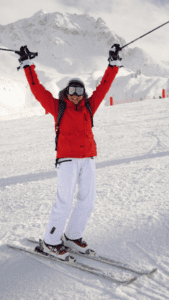How Kinesiology Can Improve Your Ski Season
With the snow finally starting to fall, many people are more than eager to get out to the ski hill. However, the thrill of carving down the slopes comes with its fair share of risks, as riders are prone to various injuries. Kinesiology, the study of body movement and mechanics, plays a pivotal role in both preventing and rehabilitating snowboard and ski injuries. Let’s explore how this science can be your ally for a safer and more enjoyable winter sports experience.
Preparing the Body:
Kinesiology focuses on assessing and enhancing body movement. Prior to hitting the slopes, a kinesiologist can develop customized exercise programs that improve strength, flexibility, and balance. These targeted routines not only prepare the body for the physical demands of snowboarding and skiing but also reduce the likelihood of injuries.
Joint Stability and Injury Prevention:
Snowboarding and skiing heavily rely on joints, making them susceptible to injuries. Kinesiologists analyze joint stability and design exercises to strengthen the supporting muscles. This proactive approach minimizes the risk of sprains by ensuring that joints are well-supported during dynamic movements on the snow.
Skiing’s Unique Demands:
Skiing places distinct demands on the body, requiring lateral movements and intricate control. Kinesiology addresses these nuances by designing exercises that enhance lateral stability, improve turning mechanics, and bolster the muscles crucial for navigating the slopes. This targeted approach ensures that skiers are well-prepared for the precise kinetic demands of their sport.
Snowboarding’s Dynamic Movements:
Snowboarding, with its emphasis on dynamic movements and asymmetrical stances, presents its own set of kinetic challenges. Kinesiology tailors exercise regimens to strengthen the muscles involved in turning, balancing, and absorbing shocks. By honing in on these specific kinetic elements, snowboarders can enjoy their sport with reduced vulnerability to injuries.
Biomechanical Analysis:
Kinesiologists use biomechanical analysis to assess movement patterns. By identifying any irregularities or imbalances, they can tailor interventions to correct these issues, reducing the strain on joints and muscles. This proactive approach helps prevent injuries caused by faulty biomechanics.
Rehabilitating Muscular Injuries:
In the unfortunate event of a snowboarding or skiing injury, kinesiology is a key player in the rehabilitation process. Kinesiologists develop rehabilitation programs tailored to the specific injury, focusing on rebuilding strength, flexibility, and coordination. These programs ensure a comprehensive recovery that minimizes the risk of re-injury. Furthermore, kinesiologists prescribe exercises that target the affected area and can be done at home. These exercises promote healing by improving blood circulation, reducing inflammation, and restoring normal function.
Kinesiology emerges as a crucial ally in the world of snowboarding and skiing, offering both preventive and rehabilitative solutions. By harnessing the science of body movement, enthusiasts can enjoy winter sports with reduced injury risks. So, whether you’re gearing up for the season or recovering from a spill, consider integrating kinesiology into your winter sports journey for a safer and more resilient experience on the slopes.





